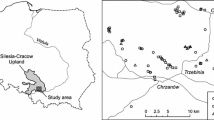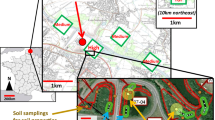Abstract
Heavy-metal content is assumed to be the most important edaphic factor that determines vegetation composition on contaminated soil. We compared the effects of heavy metals on species composition and species richness in the heavy metal-dry grassland complex of the Bottendorf Hills (Central Germany) with those of other environmental factors. Based on 206 relevés, we distinguished nine communities of the classesKoelerio-Corynephoretea andFestuco-Brometea. Four communities in which the metallophytesArmeria maritima subsp.halleri andMinuartia verna subsp.hercynica occurred with high frequency were classified as heavy metal subassociations of four different dry grassland associations because of the dominance of dry grassland species. We measured the soil content of copper, zinc and lead, and the carbonate content, C/N ratio, pH and conductivity of the soil, soil depth and incident radiation per site. The first axis resulting from a DCA was positively correlated with the cover and height of the herb layer, the soil depth and soil carbonate content, and negatively with the soil content of copper, the proportion of rocks, the soil C/N ratio and incident radiation per site. The number of vascular plants, bryophyte and lichen species per plot increased with pH up to 7.5 and then decreased slightly. Species richness increased with carbonate content and conductivity of the soil and decreased with the soil C/N ratio. Heavy metal content of the soil and species richness were not correlated. The occurrence of the metallophytes was strongly related to the copper content of the soil. In conclusion our study has shown that heavy metal content is not necessarily the main factor determining the total composition and richness of grasslands on soil containing heavy metals. Heavy metal grasslands are not necessarily floristically distinct from “normal” dry grasslands.
Similar content being viewed by others
References
Alloway B.J. (ed.) (1999):Schwermetalle in Böden: Analytik, Konzentration, Wechselwirkungen. Springer, Berlin-Heidelberg.
Antonovics J., Bradshaw A.D. &Turner R.G. (1971): Heavy metal tolerance in plants.Advances Ecol. Res. 7: 1–85.
Baumbach H. &Hellwig F.H. (2003): Genetic variation within and among metal-tolerant and non-tolerant populations ofArmeria maritima (Mill.)Willd. s.l. (Plumbaginaceae) in Central and Northeast Germany.Pl. Biol. 5: 186–193.
Baumbach H. (2005): Genetische Differenzierung mitteleuropäischer Schwermetallsippen vonSilene vulgaris, Minuartia verna undArmeria maritima unter Berücksichtigug biogeographischer, montanhistorischer und physiologischer Aspekte.Diss. Bot. 398: 1–128.
Becker T. (1998): Die Pflanzengesellschaften der Felsfluren und Magerrasen im unteren Unstruttal (Sachsen-Anhalt).Tuexenia 18: 153–206.
Becker T. (2003): Auswirkungen langzeitiger Fragmentierung auf Populationen am Beispiel der reliktischen SteppenrasenartAstragalus exscapus L. (Fabaceae).Diss. Bot. 380: 1–210.
Bergmeier E., Härdtle W., Mierwald U., Nowak B. &Peppler C. (1990): Vorschläge zur syntaxonomischen Arbeitsweise in der Pflanzensoziologie.Kieler Not. Pflanzenk. Schleswig-Holstein Hamburg 20: 92–103.
Bobbink R. (1991): Effects of nutrient enrichment in Dutch chalk grassland.J. Appl. Ecol. 28: 28–41.
Brown G. (1994): Soil factors affecting patchiness in community composition of heavy metal-contaminated areas of Western Europe.Vegetatio 115: 77–90.
Brown G. (2001): The heavy-metal vegetation of north-western mainland Europe.Bot. Jahrb. Syst. 123: 63–110.
Chytrý M., Tichý L. &Roleček J. (2003): Local and regional patterns of species richness in central European vegetation types along the pH/calcium gradient.Folia Geobot. 38: 429–442.
Clark R.K. &Clark S.C. (1981): Floristic diversity in relation to soil characteristics in a lead mining complex in the Pennines, England.New Phytol. 87: 799–815.
Colwell R.K. &Lees D.C. (2000): The mid-domain effect: geometric constraints on the geography of species richness.Trends Ecol. Evol. 15: 70–76.
Deutscher Wetterdienst (2006): www.dwd.de/de/FundE/Klima/KLIS/daten/online/nat/index_mittelwerte.htm.
Dupré C., Wessberg C. &Diekmann M. (2002): Species richness in deciduous forests: effects of the species pools and environmental variables.J. Veg. Sci. 13: 505–516.
Ernst W. (1974):Die Schwermetallvegetation der Erde. Fischer, Stuttgart.
Ernst W. (1976): Ökologische Grenze zwischenVioletum calaminariae undGentiano-Koelerietum.Ber. Deutsch. Bot. Ges. 89: 381–390.
Ernst W.H.O. (1990): Mine vegetation in Europe. In:Shaw A.J. (ed.),Heavy metal tolerance in plants: Evolutionary aspects, CRC Press Inc., Boca Raton, pp. 21–37.
Ernst W.H.O., Verkleij J.A.C. &Schat H. (1992): Metal tolerance in plants.Acta Bot. Neerl. 41: 229–248.
Ewald J. (2003): The calcareous riddle: why are there so many calciphilous species in the Central European flora?Folia Geobot. 38: 357–366.
Grace J.P. (1999): The factors controlling species density in herbaceous plant communities: an assessment.Perspect. Pl. Ecol. Evol. Syst. 2: 1–28.
Grime J.P. (1979):Plant strategies and vegetation processes. Wiley, Chichester.
Grubb P.J. (1987): Global trends in species-richness in terrestrial vegetation: a view from the northern hemisphere. In:Gee J.H.R. &Giller P.S. (eds.),Organization of communities, past and present, Blackwell, Oxford, pp. 99–118.
Hall J.L. (2002): Cellular mechanisms for heavy metal detoxification and tolerance.J. Exp. Bot. 53: 1–11.
Koperski M., Sauer M., Braun W. &Gradstein S.R. (2000): Referenzliste der Moose Deutschlands.Schriftenreihe Vegetationsk. 34: 1–519.
Kruckeberg A.R. &Kruckeberg A.L. (1990): Endemic metallophytes: their taxonomic, genetic, and evolutionary attributes. In:Shaw A.J. (ed.),Heavy metal tolerance in plants: Evolutionary aspects, CRC Press Inc., Boca Raton, pp. 301–312.
Kugler H. &Schmidt W. (eds.) (1988):Das Gebiet an der unteren Unstrut. Akademie-Verlag, Berlin.
Lefébvre C. &Vernet P. (1990): Microevolutionary processes on contaminated deposits. In:Shaw A.J. (ed.),Heavy metal tolerance in plants: Evolutionary aspects, C.R.C. Press Inc., Boca Raton, pp. 285–300.
Leipold J. (1992): Die Bottendorfer Kupferhütte im Wandel der Zeiten 1689–1813.Veröff. Kreisheimatmus. Bad Frankenhausen 14: 1–43.
Lepš J. (2005): Diversity and ecosystem function. In:van der Maarel E. (ed.),Vegetation ecology, Blackwell, Oxford, pp. 199–237.
Lindsay W.L. &Norwell W.A. (1978): Development of a DTPA soil test for zinc, iron, manganese and copper.Soil Sci. Soc. Amer. J. 42: 421–428.
Löbel S., Dengler J. &Hobohm C. (2006): Species richness of vascular plants, bryophytes and lichens in dry grasslands: The effects of environment, landscape structure and competition.Folia Geobot. 41: 377–393.
Löffler J. (1962): Die Kali- und Steinsalzlagerstätten des Zechsteins in der DDR, Teil 3: Sachsen-Anhalt.Freiberger Forschungshefte, Leipzig C97: 1–347.
McCune B. &Keon D. (2002): Equations for potential annual direct incident radiation and head load.J. Veg. Sci. 13: 603–606.
Miller R.G. (1981):Simultaneous statistical inference. McGraw Hill, New York.
Oberdorfer E. &Korneck D. (1993): Klasse:Festuco-Brometea. In:Oberdorfer E. (ed.),Süddeutsche Pflanzengesellschaften, Teil 2, Ed. 3, G. Fischer, Jena, pp. 86–180.
Pärtel M. &Zobel M. (1999): Small-scale species richness in calcareous grasslands determined by the species pool, community age and shoot density.Ecography 22: 153–159.
Pärtel M. (2002): Local plant diversity patterns and evolutionary history at the regional scale.Ecology 83: 2361–2366.
Partzsch M. (2000): Die Porphyrkuppenlandschaft des unteren Saaletals — Struturwandel ihrer Vegetation in den letzten vier Jahrzehnten.Tuexenia 20: 153–187.
Pausas J.G. (1994): Species richness patterns in the understory of PyreneanPinus sylvestris forest.J. Veg. Sci. 5: 517–524.
Rennwald E. (ed.) (2000): Verzeichnis und Rote Liste der Pflanzengesellschaften Deutschlands.Schriftenreihe Vegetationsk. 35: 1–800.
Scholz P. (2000): Katalog der Flechten und flechtenbewohnenden Pilze Deutschlands.Schriftenreihe Vegetationsk. 31: 1–298.
Schubert R. (1953): Die Schwermetallpflanzengesellschaften des östlichen Harzvorlandes.Wiss. Z. Martin-Luther-Univ. Halle-Wittenberg, Math.-Naturwiss. R. 3: 51–70.
Schubert R. (1954): Die Pflanzengesellschaften der Bottendorfer Höhe.Wiss. Z. Martin-Luther-Univ. Halle-Wittenberg, Math.-Naturwiss. R. 4: 99–120.
Schulz A. (1912): Über die auf schwermetallhaltigen Boden wachsenden Phanerogamen Deutschlands.Jahres-Ber. Westfäl. Prov.-Vereins Wiss. 40: 209–227.
Schuster B. &Diekmann M. (2003): Changes in species density along the soil pH gradient — Evidence from German plant communities.Folia Geobot. 38: 367–379.
Simon E. (1978): Heavy metals in soils, vegetation development and heavy metal tolerance in plant populations from metalliferous areas.New Phytol. 81: 175–188.
Sjörs H. (1950): On the relation between vegetation and electrolytes in North Swedish mire waters.Oikos 2: 241–258.
SPSS Inc. (2001):SPSS 11.0 for Windows and Smart-ViewerTM. SPSS Inc., Chicago.
ter Braak C.J.F. &Šmilauer P. (2002):CANOCO reference manual and CanoDraw for Windows user’s guide: Software for canonical community ordination 4.5. Microcomputer Power, Ithaca.
Tyler G. (1996): Soil chemistry and plant distributions in rock habitats of southern Sweden.Nordic J. Bot. 16: 609–635.
Vekemans X. &Lefebvre C. (1997): On the evolution of heavy-metal tolerant populations inArmeria maritima: evidence from allozyme variation and reproductive barriers.J. Evol. Biol. 10: 175–191.
Wagenbreth O. &Steiner W. (1982):Geologische Streifzüge. Deutscher Verlag für Grundstoffindustrie, Leipzig.
Walker D.A., Bockheim J.G., Chapin III F.S., Eugster W., Nelson F.E. &** C.L. (2001): Calcium-rich tundra, wildlife, and the “Mammoth Steppe”.Quatern. Sci. Rev. 20: 149–163.
WallisDeVries M.F., Poschlod P. &Willems J.H. (2002): Challenges for the conservation of calcareous grasslands in northwestern Europe: integrating the requirements of flora and fauna.Biol. Conservation 104: 265–273.
Weidauer K. & Hiller E. (1993):Schutzwürdigkeitsgutachten Landkreis Artern “Bottendorfer Höhe”. Unpubl. manuscript, Bottendorf.
Wilson J.B. (1988): The cost of heavy metal tolerance: an example.Evolution 42: 408–413.
Wisskirchen R. &Haeupler H. (1998):Standardliste der Farn-und Blütenpflanzen Deutschlands. Ulmer, Stuttgart.
Author information
Authors and Affiliations
Corresponding author
Rights and permissions
About this article
Cite this article
Becker, T., Brändel, M. Vegetation-environment relationships in a heavy metal-dry grassland complex. Folia Geobot 42, 11–28 (2007). https://doi.org/10.1007/BF02835100
Received:
Revised:
Accepted:
Issue Date:
DOI: https://doi.org/10.1007/BF02835100




